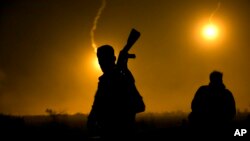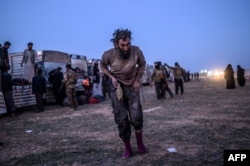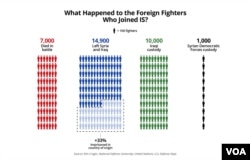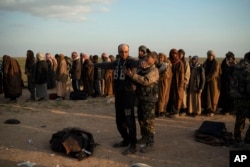This is part one of a four-part series.
WASHINGTON — Even as the Islamic State’s caliphate was clinging to life with its last defenders cornered in a small town in northeastern Syria, the terror group managed to shock those who would eventually see it die.
Instead of waiting out about 1,000 civilians and 300 or so hard-core IS fighters who had retreated to Baghuz, the U.S.-led coalition watched for weeks in late February and March, as upwards of 30,000 civilians and 5,000 fighters, slowly surrendered.
“Very much unanticipated,” a senior U.S. defense official said at the time, describing what he called “the magnitude of humanity” flowing out of the terror group’s final shred of territory.
“We continue to be surprised by the numbers,” the official added.
But when it comes to the Islamic State terror group, numbers have always been a challenge for the United States and its partners, starting with their first efforts to measure the terror group’s appeal to would-be jihadists from across the globe.
Counting IS foreign fighters
And it is that same uncertainty that has some officials and analysts worried that the narrative surrounding the demise of IS foreign fighters – that the majority are dead or in custody – may be wrong.
“We still have pretty reasonable numbers still in the region right now that are almost certainly active,” said Seth Jones, director of the Transnational Threats Project at the Center for Strategic and International Studies.
“It’s hard to know if some have stayed and given up the fight,” said Jones, who has been studying the rise of Salafi-jihadist movements worldwide. “But the fact that they’re still there, just the fact that they’re free, indicates that there’s a reasonable chance they’re still committed to jihadist activity.”
Just this past week, those jihadis got a call to arms when IS issued a new video of reclusive leader Abu Bakr al-Baghdadi urging followers to seek vengeance for the fall of Baghuz.
“The threat persists,” said U.S. Assistant Secretary of State for Stabilization Denise Natali. "ISIS remains a determined enemy as evidenced by Abu Bakr al-Baghdadi's first appearance in years…exhorting his supporters to keep up the fight despite territorial losses."
U.S. intelligence officials first began raising concerns about jihadists, or so-called foreign fighters, flocking to the growing civil war in Syria in early 2014, estimating there were about 7,500 from some 50 countries.
Just a year later, the estimated number of fighters in Syria and Iraq had more than doubled.
And the numbers are growing even now, not from a new influx but as intelligence services the world over continue to learn of more people, young and old, who left their homes to fight under the banner of the black flag.
Senior U.S. counterterrorism officials told VOA that at last count, an estimated 45,000 fighters — a jump of 5,000 from the previous estimate — had flooded the battlefields of Syria and Iraq, almost all in the name of IS.
Tracking IS foreign fighters
If getting a grip on the number of foreign fighters who joined Islamic State has been challenging, following them once they joined the terror group’s ranks has been even more difficult.
To be sure, many have been killed. But at least about 15,000 are thought to have left the caliphate, two-thirds of whom are likely still at large.
According to an August 2018 report by the United Nations, another 10,000 fighters were in Iraqi custody.
More recently, U.S. defense officials have said at least 2,000 more are being held by the Syrian Democratic Forces, the predominantly Kurdish force that liberated IS’ last pocket of territory in the Middle Euphrates River Valley.
“We anticipate that number will rise as we work with the SDF to verify the national identities of ISIS fighters in SDF custody,” said Pentagon spokesman Commander Sean Robertson, using an acronym for the terror group.
Still, thousands more are as of yet unaccounted for, the U.N. report warning that as of mid-2018, increasing numbers were finding refuge in Afghanistan, “bringing with them skills in handling weaponry and improvised explosive devices and knowledge of military tactics.”
“Central Asian fighters tend to feel most comfortable relocating among Afghans of Uzbek and Tajik ethnicity,” the United Nations said.
Other foreign fighters, perhaps fearing the imminent collapse of the IS caliphate in Syria, may have made their way back to Iraq by exploiting vulnerabilities along the Syria-Iraq border.
Some even continued to join the fight.
Coalition officials told the U.S. Defense Department Inspector General this past January, “the actual number is unknown but estimated that it is ‘most likely 50 per month.’”
The numbers, and the threat they represent, have resonated to a degree at the highest levels of the U.S. government.
“We're under no illusions that this issue writ-large has gone away,” a senior U.S. administration official said this past December when asked about IS’ staying power in Syria and Iraq.
“In terms of the next phase of the mission, it is continuing to remain vigilant about the ongoing threat of ISIS,” the official said, pointing to places like Libya and Egypt’s Sinai Peninsula, long seen as potential landing spots for surviving foreign fighters.
U.S. intelligence officials have also warned that foreign fighters could find refuge with IS branches, or even less formal networks, in more than a dozen other countries, including Turkey, which for years had served as a gateway for foreign fighters looking to enter Syria.
With the collapse of the terror group’s territorial control in Iraq and Syria, such concerns are starting to take center stage.
“We're going to remain very vigilant about potential ISIS activities and their related groups,” the senior official said, anticipating this moment. “Across the region and around the world, quite frankly.”
This story is the first in a series looking at the threat of IS foreign fighters. Next up, a look at where the IS foreign fighters are going now.





